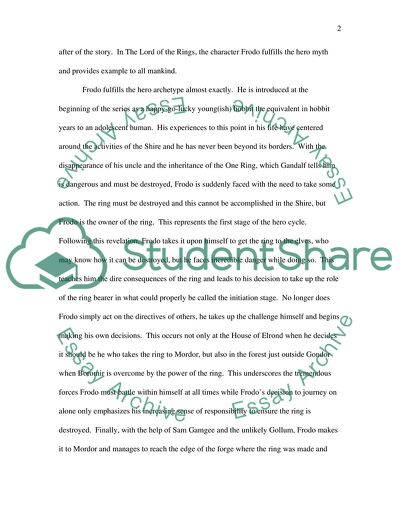
- Home
- Free Samples
- Premium Essays
- Editing Services
- Extra Tools
- Essay Writing Help
- About Us
- Studentshare
- Subjects
- Miscellaneous
- The Lord of the Rings - The Fellowship of the Ring - Paper Assignment
The Lord of the Rings - The Fellowship of the Ring - Paper Assignment - Essay Example

- Subject: Miscellaneous
- Type: Essay
- Level: Undergraduate
- Pages: 4 (1000 words)
- Downloads: 0
- Author: awiza
Extract of sample "The Lord of the Rings - The Fellowship of the Ring - Paper Assignment"
“Jung says that unless we pass through this second stage the individual can’t really become an adult. The function of the hero myth is to develop a person’s awareness of his strengths and weaknesses in order to face life’s problems” (Garbis, 2002). Within this myth, the symbolic (and sometimes real) death of the hero functions as a key to the concept that the individual has gained maturity and has been reborn into the image of the father or mentor. The third stage of the individuation process is known as transcendence and is that stage in the maturation process in which the unconscious and the conscious minds merge to enable the person to experience their full potential.
It is the happily ever after of the story. In The Lord of the Rings, the character Frodo fulfills the hero myth and provides example to all mankind. Frodo fulfills the hero archetype almost exactly. He is introduced at the beginning of the series as a happy-go-lucky young(ish) hobbit the equivalent in hobbit years to an adolescent human. His experiences to this point in his life have centered around the activities of the Shire and he has never been beyond its borders. With the disappearance of his uncle and the inheritance of the One Ring, which Gandalf tells him is dangerous and must be destroyed, Frodo is suddenly faced with the need to take some action.
The ring must be destroyed and this cannot be accomplished in the Shire, but Frodo is the owner of the ring. This represents the first stage of the hero cycle. Following this revelation, Frodo takes it upon himself to get the ring to the elves, who may know how it can be destroyed, but he faces incredible danger while doing so. This teaches him the dire consequences of the ring and leads to his decision to take up the role of the ring bearer in what could properly be called the initiation stage.
No longer does Frodo simply act on the directives of others, he takes up
...Download file to see next pages Read MoreCHECK THESE SAMPLES OF The Lord of the Rings - The Fellowship of the Ring - Paper Assignment
The Lord of the Rings - The Fellowship of the Ring
Lord of the Rings Fellowship of the Rings by John Ronald Reuel Tolkien
Conflicts Coverage in Lord of the Ring
The Lord Of The Ring
Book and Movie versions of Lord of the Rings The Fellowship of the Ring
The Lord of the Rings
3D Animation and Techniques: Education and Entertainment
Lord of the Rings, The Fellowship of the Ring Synopsis and Recommendation

- TERMS & CONDITIONS
- PRIVACY POLICY
- COOKIES POLICY